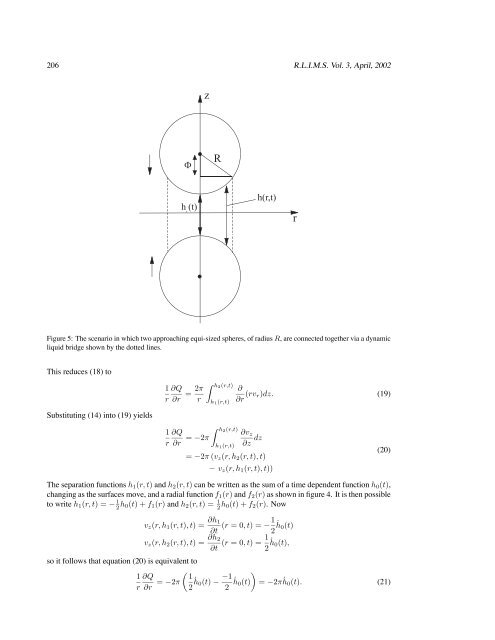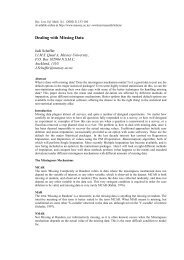Mathematical Modelling of Granulation: Static and Dynamic Liquid ...
Mathematical Modelling of Granulation: Static and Dynamic Liquid ...
Mathematical Modelling of Granulation: Static and Dynamic Liquid ...
You also want an ePaper? Increase the reach of your titles
YUMPU automatically turns print PDFs into web optimized ePapers that Google loves.
206 R.L.I.M.S. Vol. 3, April, 2002<br />
Figure 5: The scenario in which two approaching equi-sized spheres, <strong>of</strong> radius R,are connected together via a dynamic<br />
liquid bridge shown by the dotted lines.<br />
This reduces (18) to<br />
Substituting (14) into (19) yields<br />
h2(r,t)<br />
1 ∂Q 2π ∂<br />
=<br />
r ∂r r h1(r,t) ∂r (rvr)dz. (19)<br />
h2(r,t)<br />
1 ∂Q<br />
∂vz<br />
= −2π<br />
r ∂r h1(r,t) ∂z dz<br />
= −2π (vz(r, h2(r, t),t)<br />
− vz(r, h1(r, t),t))<br />
The separation functions h1(r, t) <strong>and</strong> h2(r, t) can be written as the sum <strong>of</strong> a time dependent function h0(t),<br />
changing as the surfaces move, <strong>and</strong> a radial function f1(r) <strong>and</strong> f2(r) as shown in figure 4. It is then possible<br />
to write h1(r, t) =− 1<br />
2 h0(t)+f1(r) <strong>and</strong> h2(r, t) = 1<br />
2 h0(t)+f2(r). Now<br />
so it follows that equation (20) is equivalent to<br />
vz(r, h1(r, t),t)= ∂h1<br />
(r =0,t)=−1<br />
∂t 2 ˙ h0(t)<br />
vz(r, h2(r, t),t)= ∂h2<br />
(r =0,t)=1<br />
∂t 2 ˙ h0(t),<br />
1 ∂Q<br />
= −2π<br />
r ∂r<br />
1<br />
2 ˙ h0(t) − −1<br />
2 ˙ h0(t)<br />
(20)<br />
<br />
= −2π ˙ h0(t). (21)








